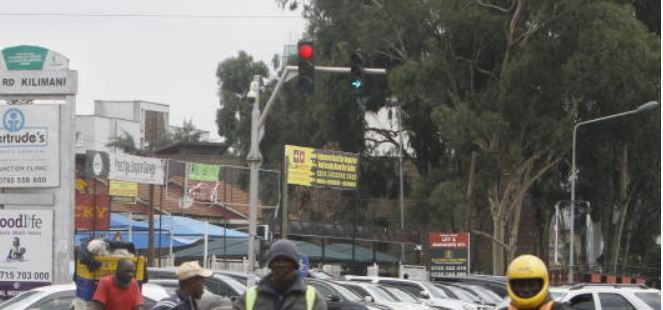AfricaPress-Kenya: They wait patiently at the traffic lights. Perfunctorily, they check their mobile phones perhaps for a missed call or a text.
At this, the traffic light turns amber, then suddenly green, and a long queue of vehicles slowly snake down Ring Road Kilimani.
It is the Intelligent Transport System, piloted by Huawei, that has brought sanity on Ngong Road, previously known for congestion, disorder and crawling traffic.
Using Artificial Intelligence (AI), Huawei, the Chinese-owned Telco, partnered with Kenya Urban Roads Authority (KURA), to apply intelligent cameras and variable timing traffic lights to manage traffic along the road.
Martin Njuguna, a boda boda rider in the city, has seen many of his colleagues crash to death before and thus appreciates the traffic lights.
Most of these have found themselves on the wrong side of the law on the road, breaking traffic rules at will and inviting the wrath of the grim reaper when it was easier to avoid it. At the Kenyatta Hospital roundabout where he sits astride his motorcycle and waits for that intermittent trip, he reminisces sad moments he has encountered along Ngong Road.
“Boda bodas rush into road intersections and sometimes into the path of speeding vehicles. There have been a lot of accidents along Ngong Road, especially at the junctions.”
Pedestrians too. Many have been crushed in the busy highway in the past.
Nairobi’s bad traffic culture is legendary.
But it is changing. A sense of orderliness has seen the accidents reduce significantly, he points out.
Traffic is a factor of behavior. Research has shown that technology beats even the most stubborn of cultures.
Nairobi’s residents are forever struggling to avoid maddening gridlock or struggling to get out of one. The entry and exit from the city is a negotiated, fear-inducing affair. Skyscrapers hosting executive office suits shoot into the sunny skyline giving the city an unmatched attractiveness while brisk business roars in the CBD.
Yet dysfunctional traffic rights, complemented by traffic officers manning junctions, ruins the swanky image.
Faulty traffic lights give way to a free-for-all madness that often leads to more chaos and gridlock: matatus will overlap, motorcyclists will cut in from whichever side, while private motorists curse in exasperation.
Traffic snarl-ups and congestion cost Nairobi Sh50 million per day, according to one estimate. Considering the stress it induces on motorists and air pollution, the cost is a staggering Sh100 million a day.
The Intelligent Transport System (ITS) project that started in 2017 with seven junctions along the Nairobi Western Ring Roads and a traffic management centre is one way no less significant to free up the congestion and get the city moving.
From the Traffic Management Center at Barabara Plaza – which also houses other road agencies- traffic marshals monitor the status of city roads from a dozen CCTV video surveillance, vehicle video detectors, an intelligent traffic lights system and an e-police system.
KURA attributes the change in most of the drivers’ behaviour to this technology.
“This (the inception) has led to improved traffic efficiency at least by 40 per cent from Pilot Survey Analysis. We can also appreciate reduced accidents due to reduced conflicts on the roads. There is also an improved waiting time to average 22 seconds at the junctions,” says Silas Kinoti, the Director General of Kenya Urban Road Authority.
Previously, it ran into minutes.
“At the end of the day it is about people’s mentality and discipline,” an officer at the Adams Arcade roundabout says, but quickly adds that the ITS has created an order “in some sense”.
“We still have boda bodas that overlap, and PSVs that sometimes break the rules as they try to maximize their daily returns. A lot of them are aware that they are being watched and that has tamed them in a big way.”
Transport infrastructure should be efficient to ensure seamless mobility of goods and people. This will translate to livable cities with low traffic congestion levels, low travel times and easy connectivity between various modes. It is one of the key enablers to the economic development and growth of a country. This is well envisioned in Kenya Vision 2030.
Efficient transport systems ideally increase economic activity and thus boosting every country’s Gross Domestic Product (GDP).
Data from the Kenya National Bureau of Statistics’ (KNBS) Economic Survey in 2019 indicated an improved performance in the transport and storage sector with the value of output increasing by 12.1 per cent to Sh1.4 trillion.
Over 470, 000 people were engaged in transport and communication activities in the country in the year, as direct employees. That means making road use more efficient and easy has a multiplier effect on the economy including more opportunities for people.
Huawei integrated ITS cameras adopt unique integrated design and have built-in motorized zoom lenses. They are applicable to most traffic intersection scenarios, thus alleviating the site survey workload. The cameras use global shutter sensors that support capture of vehicles at high speeds, are good at vehicle type recognition, and are capable of a variety of traffic violation detections such as jumping the red lights.
The city’s arterial, collector and local roads has created a connectivity and linkages across the road network.
In spite of a raft of past interventions, congestions levels remain high in Nairobi. The country has more than 3.5 million vehicles with more than half of them in the capital city. Every day, the city roads welcome new vehicles.
“Travel patterns have become unpredictable due to traffic jams forcing most people to start their journeys early, and leading to loss of productive time. Vehicle operation costs are also high,” says Engineer Kinoti.
Road traffic accidents are still high with close to 3,600 fatalities last year. The majority of these people are vulnerable road users – pedestrians, motorcyclists, and bicyclists.
Huawei’s ITS aims to create an order on roads that leads to decline, and an end to avoidable accidents.
Judith Anyango runs a kiosk and M-Pesa shop along the road. She has been here since 2006, and according to her, the greatest impediment to smooth transport system in the area was always the occasional accidents, mainly involving pedestrians and boda boda.
“The main change I can associate with the lights is the reduction in accidents. It is safer on the roads now,” she says.
According to KNBS, The number of reported traffic accidents increased by 39.3 per cent from 5,158 in 2018 to 7,184 in 2019. The number of reported casualties increased by 22.3 per cent to 15,747 in 2019. The number of people that were seriously injured in the accidents increased by 48.5 per cent to 6,952 while those that died increased by 13.6 per cent to 3,586 in 2019. The reasons given for the increase in accidents were losing control, improper overtaking, speeding and crossing the road without due care at the junctions.
“The pilot is just a start, Nairobi has more than 400 junctions on which we plan to deploy ITS technology. We are planning to develop 25 junctions and a Metropolitan-Wide Traffic Management center in Phase I, 77 Junctions in Phase II and 125 Junctions in Phase III. All to be completed in three years’ time. This will reduce the traffic accidents by 40 per cent, improve traffic efficiency by 60 per cent,” Mr Kinoti says.
Although Boniface Mbure, a taxi driver, has twice found himself idling behind a long line of vehicles with the light having turned red a couple of times in under three minutes, he is glad every driver is obeying the law.
“The traffic flow is so well controlled, the accidents have reduced and the congestions that were brought about by senseless overlapping and blocking of the intersection have reduced.”
The lights turn amber, then green. Mbure’s Toyota Vitz guns forward, this time just in time to avoid another red. You cannot help smile at the smoothness of traffic flow.






